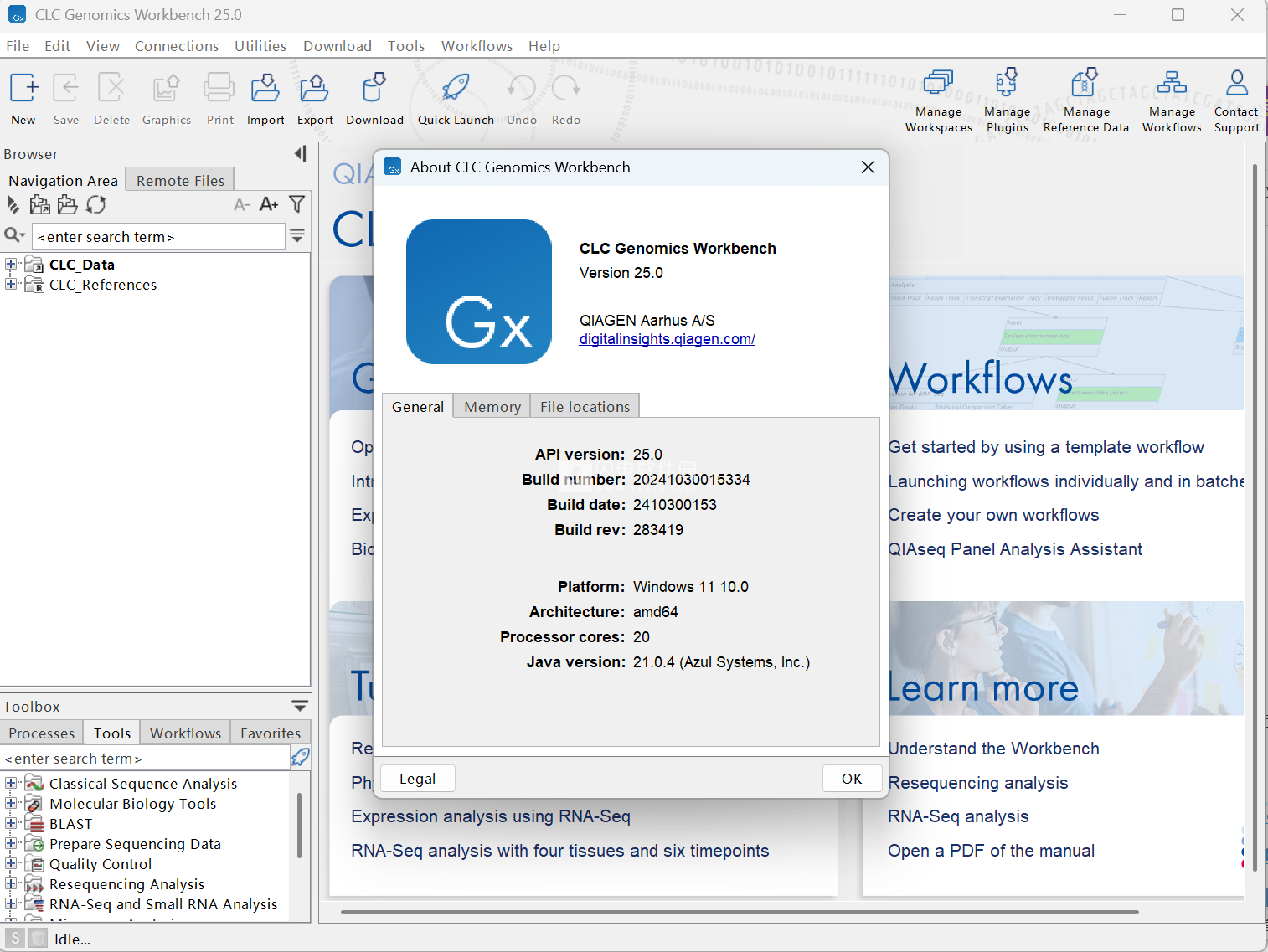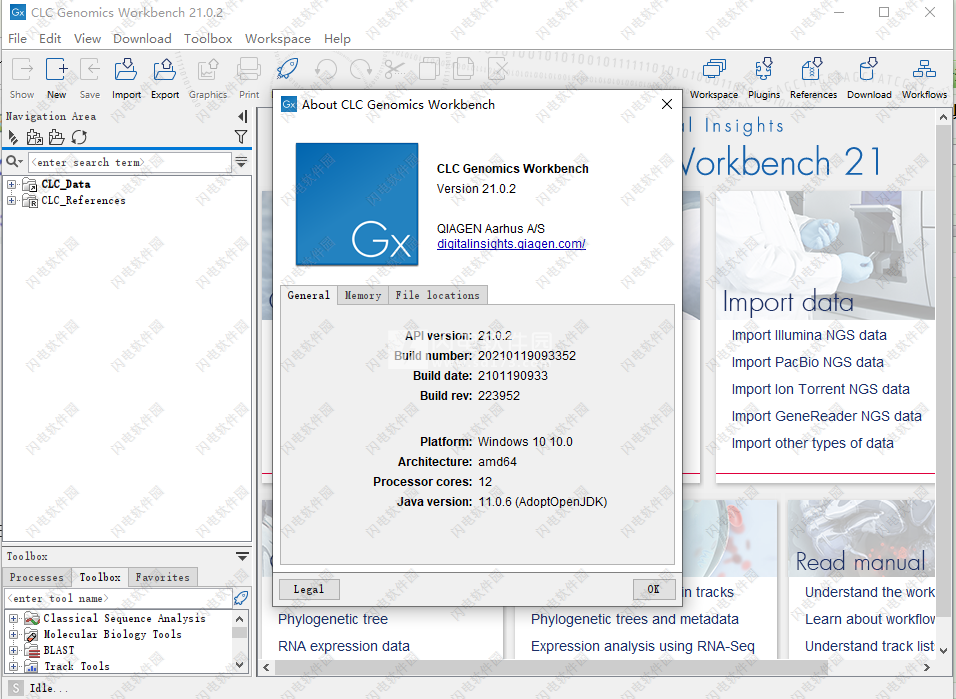CLC Genomics Workbench是一个功能强大的解决方案,适合任何物种、任何平台、任何工作流程的NGS数据分析!用于分析,比较和可视化下一代测序数据,具有直观和用户友好界面的跨平台桌面应用程序,融合了最先进的技术和算法。包括基因组学,转录组学和表观基因组学的众多功能,支持所有主要的下一代测序平台,使用QIAGEN CLC Genomics Workbench 24扩展您的研究,现在具有Sanger测序工作流程,性能增强,长读RNA测序分析,单元型调用者*和HID面板支持*的功能。提供一整套包括微生物和宏基因组学,单细胞分析或小基因组处理的功能,欢迎有需要的朋友不要错过了!


功能特色
1、使用Cloud插件从Illumina BaseSpace或Amazon S3中导入数据。
建立端到端的桑格测序工作流程,从跟踪数据到共识对齐。桑格程序集现在也可以通过读取包装来可视化。
根据元数据或批处理标识符自动命名工作流输出。
2、使用工作流进行分析
对于涉及到几种算法工具的管道的更复杂的数据分析,请查看我们的工作流系统。有了工作流,您就可以链接并配置单个的工具,这样就可以轻松且可重复地启动完整的分析。
工作流可以很容易地共享,您可以选择在启动工作流时可以调整哪些参数,以及应该为所有运行锁定哪些参数的特定值。
3、工具——工作台的核心
这个工具箱形成了CLC Genomics工作台的核心。工具箱菜单下有各种各样的工具,重点关注NGS数据分析。大多数工具都提供了可以配置的选项,因此您可以调整分析以满足您的目的。
4、管理参考文献
参考数据管理器帮助您下载最常见的参考生物和数据库的最新版本。
所有参考资料要么直接从公共资源下载,如Ensembl,或由我们在QIAGEN Digital Insights策划,以完全符合我们的随时可用的工作流程的需求。
5、更智能地使用元数据
在工作台中使用元数据以一种方便的方式组织示例和结果,并享受它的多功能性。使用元数据查找对象,在批处理中定义输入的分组,在工作流中引导样本到不同的路径(例如在肿瘤-正常或三重研究中),或在RNA-Seq的统计分析和可视化中。你所需要的只是一个Excel电子表格。
6、高级配料制作简单
你的研究可能会提供很多样本,但我们会支持你的分析。工作流使分析大量批次变得容易,即使涉及到许多工具,并且生成了许多样品的结果。
您可以用任意数量的输入来批处理一个工作流:只需在输入选择步骤的“批处理”框中选中您希望批处理的每个输入选择。
对于跨示例分析,您现在可以在单个工作流中批处理和聚合。只需将批处理部分包含在“Iterate”和“Collect and Distribute”元素之间。
安装激活教程
1、在本站下载并解压,如图所示
2、双击CLCGenomicsWorkbench_24_0_1_64.exe运行安装,勾选我接受协议
3、选择软件安装路径
4、安装完成,不要启动程序,退出向导
5、安装后激活
3、选择软件安装路径
4、安装完成,不要启动程序,退出向导
5、安装后激活
6、管理员身份运行程序,勾选important a license from a file选项
8、点击如下按钮,选择CLC-LICENSE-CLCGENOMICSWB.lic许可证文件即可
9、对于插件,管理员身份运行成本线,然后依次点击帮助-插件
9、对于插件,管理员身份运行成本线,然后依次点击帮助-插件
10、如图所示,点击“从文件安装”,选择插件文件夹中的 .cpa文件
11、勾选同意协议
12、安装成功,其它的插件以此类推,同样的操作
11、勾选同意协议
12、安装成功,其它的插件以此类推,同样的操作
闪电小编说明:
生物医学基因组学分析软件,提供完整的功能,用户友好的生物信息学软件解决方案可以全面分析您的NGS数据,包括全基因组和转录组从头组装,靶向重测序分析,变体调用,ChIP-seq和DNA甲基化(亚硫酸氢盐测序分析)。通过用于分类学和功能性微生物组分析的工具和简化的分析工作流程,可以轻松理解复杂的宏基因组数据。支持的NGS平台包括Illumina,IonTorrent,PacBio和GeneReader。
更新日志
CLC Genomics Workbench Premium 23.0.2
发布日期: 2023-02-13
改进和错误修复
氨基酸变化的运行时间得到了显着改善。
修复了“修剪读取”报告中的问题,即“修剪(断开的对)”的数量不是按作为输入提供的序列列表报告的,而是以增量方式加在一起。报告的“修剪读取”数量相应减少。当修剪来自多个序列列表的成对读取并生成损坏的读取对时,会出现此问题。
修复了一个罕见的问题,如果读取同时根据质量分数和适配器直读进行修整,则可能导致修剪读取保留读取的错误部分。
修复了导致解复用读取工具始终基于“条形码,序列”序列结构进行多重解复的问题。对标记列表的调整(例如添加链接器或将条形码放在末尾)将被忽略。在工作流上下文中运行时,此问题不会影响该工具。
修复了当数据集很大或检测到具有许多可能转录本的融合基因时,可能导致在 Windows 上检测和优化融合基因失败的问题。
修复了导出过滤的空注释轨道时可能导致 VCF 导出失败的问题。
修复了导致 Design Primers 表格中的片段长度不正确的问题。打开表格时会重新计算这些值,因此不需要重复以前的设计。
修复了导致 QIAseq xHYB 病毒面板参考数据集在 Windows 上下载失败的问题。
Fixed a rare issue where Rebuild Index could not repair a corrupt search index.
Various minor bug fixes
齐根CLC基因组学工作台 23.0.1
发布日期: 2023-01-17
改进和错误修复
Fixed an issue affecting Trim Reads, where the wrong part of a read was retained if the read was both trimmed to a fixed length and also trimmed by another method from the opposite end of the read.
Fixed an issue affecting Trim Reads when both adapter trimming using a trim adapter list and fixed length trimming were selected. This issue could cause the resulting trimmed reads to be shorter than expected.
Fixed an issue where fusion plots created by Detect and Refine Fusion Genes were omitted in the report and were not accessible via the fusion track table.
Fixed an issue where workflows containing a Branch on Coverage element would fail for read mappings with no zero coverage regions when using reports output by QC for Read Mapping.
Fixed an issue where dates indicated with forward slashes in CSV format files were not recognized as dates by Import Metadata.
Fixed an issue where the history entry in a sequence list after sorting always stated the sorting was based on length, even the sorting was based on name or marked status.
Fixed an issue causing Annotate with GFF/GTF/GVF file to fail when the option “Ignore duplicate annotation” was checked.
Fixed an issue causing Standard Import of GenBank format to stall if qualifier names spanned more than one line.
Various minor improvements
请参阅下面的 CLC 基因组学工作台 23.0 的发行说明,了解自此软件上一个常规版本以来更改的完整列表。
QIAGEN CLC 基因组学工作台 23.0
发布日期: 2023-01-17
新工具
Homology Based Cloning – Design cloning experiments for cloning methods relying on homologous ends, such as Gibson Assembly .
.
Create K-medoids Clustering for RNA-Seq finds clusters of features, e.g., genes/transcripts/miRNAs etc, whose expressions behave similarly, for example first increasing over time and then decreasing. The tool produces a Clustering Collection which contains a Sankey plot showing how these features move between clusters under different conditions, for example different treatments. A line graph representation of features from individual clusters or pairs of clusters is present as well.
来自插件的新工具
Detect and Refine Fusion Genes – Find fusion genes in RNA-Seq data by identifying potential fusions and then refining that list by evaluation of the evidence for each fusion. This is an updated version of the tool formerly distributed in the Biomedical Genomics Analysis plugin. The updates made are listed in an Improvements section below.
Target Region Coverage Analysis – Analyze and compare coverage from multiple samples. This tool was formerly distributed in the Biomedical Genomics Analysis plugin.
Create Consensus Sequences from Variants – Create consensus sequences from a variant track and a reference sequence. This tool was formerly distributed in the Biomedical Genomics Analysis plugin.
Annotate with GFF/GVF/GTF file – Add annotations from a GFF, GVF or GTF format file onto sequences, individual or in sequence lists. This tool was formerly distributed in the Annotate with GFF file plugin.
其他新功能和改进
RNA-Seq 分析工具
New tutorial: Get hands-on experience with new RNA-Seq analysis functionality, including Create K-medoids Clustering for RNA-Seq (see New Tools above), with the RNA-Seq analysis with four tissues and six timepoints tutorial.
Improvements to RNA-Seq Analysis:
Substantial speed improvements. Reads that map to multiple transcripts or genes will be distributed differently than earlier due to different choices of random seed in the new implementation. The algorithm is still deterministic.
Transcripts are no longer renamed in Transcript Expression (TE) output unless renaming is necessary to avoid duplicate names. Previously, transcripts were renamed to the gene name plus a number e.g. “BRCA_1”. This change means that TE tracks in this version of the software cannot typically be used together with TE tracks generated using older versions to produce Heat Maps, PCA plots, Expression, etc.
Reports UMI fragment counts when relevant. UMI counts are included in the Fragment statistics section of the report if the input reads are annotated with UMIs by tools from the Biomedical Genomics Analysis plugin, and if the library type is set to 3′ sequencing for RNA-Seq Analysis.
Improvements to Heat Maps:
Samples can be ordered by the Tree, Sample, or Active metadata layer options, or any individual metadata entry.
Optimize tree layouts – a new option for reordering features to produce a top-left to bottom-right diagonal.
The order of the metadata categories can be adjusted. This order is reflected in the legend.
Metadata categories are alphabetically sorted.
The Expression Browser includes a new plot for visualizing genes across samples and contrasts and metadata categories are sorted alphabetically.
Venn diagrams support four and five groups. Previously up to 3 were supported. Tooltips indicate which groups are part of a specific intersection.
PCA plots produced by PCA for RNA-Seq:
Have two table views. The first table view shows the loadings of the principal components. The second table view shows the coordinates of the points.
The order of the metadata categories in 2D PCA plots can be adjusted. This order is reflected in the legend.
miRNA 分析工具
Quantify miRNA:
Handles custom databases containing duplicated names.
Does not allow custom databases containing sequences longer than 60bp. This avoids misallocation of reads to sequences that are similar to small RNAs.
When adding multiple inputs to Extract IsomiR Counts, the extracted expression tables contain an entry for the combined set of IsomiRs identified among the samples, making them compatible for analysis in Differential Expression in Two Groups and Differential Expression for RNA-Seq.
两组RNA-seq的差异表达和差异表达
A new option for creating a subset has been added to the miRNA Statistical Comparison Table produced by Differential Expression for RNA-Seq and Differential Expression in Two Groups.
It is possible to downweigh outliers. This option is disabled by default and recommended only when the results seem enriched for genes that are expressed at anomalously high levels in a small proportion of samples.
The Max Group Means column of Statistical Comparison Tracks and Tables now shows TPM instead of RPKM. Note that this column is used for filtering data in tools such as Create Heat Map for RNA-Seq and the Pathway Analysis tool of the Ingenuity Pathway Analysis plugin.
发布日期: 2023-02-13
改进和错误修复
氨基酸变化的运行时间得到了显着改善。
修复了“修剪读取”报告中的问题,即“修剪(断开的对)”的数量不是按作为输入提供的序列列表报告的,而是以增量方式加在一起。报告的“修剪读取”数量相应减少。当修剪来自多个序列列表的成对读取并生成损坏的读取对时,会出现此问题。
修复了一个罕见的问题,如果读取同时根据质量分数和适配器直读进行修整,则可能导致修剪读取保留读取的错误部分。
修复了导致解复用读取工具始终基于“条形码,序列”序列结构进行多重解复的问题。对标记列表的调整(例如添加链接器或将条形码放在末尾)将被忽略。在工作流上下文中运行时,此问题不会影响该工具。
修复了当数据集很大或检测到具有许多可能转录本的融合基因时,可能导致在 Windows 上检测和优化融合基因失败的问题。
修复了导出过滤的空注释轨道时可能导致 VCF 导出失败的问题。
修复了导致 Design Primers 表格中的片段长度不正确的问题。打开表格时会重新计算这些值,因此不需要重复以前的设计。
修复了导致 QIAseq xHYB 病毒面板参考数据集在 Windows 上下载失败的问题。
Fixed a rare issue where Rebuild Index could not repair a corrupt search index.
Various minor bug fixes
齐根CLC基因组学工作台 23.0.1
发布日期: 2023-01-17
改进和错误修复
Fixed an issue affecting Trim Reads, where the wrong part of a read was retained if the read was both trimmed to a fixed length and also trimmed by another method from the opposite end of the read.
Fixed an issue affecting Trim Reads when both adapter trimming using a trim adapter list and fixed length trimming were selected. This issue could cause the resulting trimmed reads to be shorter than expected.
Fixed an issue where fusion plots created by Detect and Refine Fusion Genes were omitted in the report and were not accessible via the fusion track table.
Fixed an issue where workflows containing a Branch on Coverage element would fail for read mappings with no zero coverage regions when using reports output by QC for Read Mapping.
Fixed an issue where dates indicated with forward slashes in CSV format files were not recognized as dates by Import Metadata.
Fixed an issue where the history entry in a sequence list after sorting always stated the sorting was based on length, even the sorting was based on name or marked status.
Fixed an issue causing Annotate with GFF/GTF/GVF file to fail when the option “Ignore duplicate annotation” was checked.
Fixed an issue causing Standard Import of GenBank format to stall if qualifier names spanned more than one line.
Various minor improvements
请参阅下面的 CLC 基因组学工作台 23.0 的发行说明,了解自此软件上一个常规版本以来更改的完整列表。
QIAGEN CLC 基因组学工作台 23.0
发布日期: 2023-01-17
新工具
Homology Based Cloning – Design cloning experiments for cloning methods relying on homologous ends, such as Gibson Assembly
 .
.Create K-medoids Clustering for RNA-Seq finds clusters of features, e.g., genes/transcripts/miRNAs etc, whose expressions behave similarly, for example first increasing over time and then decreasing. The tool produces a Clustering Collection which contains a Sankey plot showing how these features move between clusters under different conditions, for example different treatments. A line graph representation of features from individual clusters or pairs of clusters is present as well.
来自插件的新工具
Detect and Refine Fusion Genes – Find fusion genes in RNA-Seq data by identifying potential fusions and then refining that list by evaluation of the evidence for each fusion. This is an updated version of the tool formerly distributed in the Biomedical Genomics Analysis plugin. The updates made are listed in an Improvements section below.
Target Region Coverage Analysis – Analyze and compare coverage from multiple samples. This tool was formerly distributed in the Biomedical Genomics Analysis plugin.
Create Consensus Sequences from Variants – Create consensus sequences from a variant track and a reference sequence. This tool was formerly distributed in the Biomedical Genomics Analysis plugin.
Annotate with GFF/GVF/GTF file – Add annotations from a GFF, GVF or GTF format file onto sequences, individual or in sequence lists. This tool was formerly distributed in the Annotate with GFF file plugin.
其他新功能和改进
RNA-Seq 分析工具
New tutorial: Get hands-on experience with new RNA-Seq analysis functionality, including Create K-medoids Clustering for RNA-Seq (see New Tools above), with the RNA-Seq analysis with four tissues and six timepoints tutorial.
Improvements to RNA-Seq Analysis:
Substantial speed improvements. Reads that map to multiple transcripts or genes will be distributed differently than earlier due to different choices of random seed in the new implementation. The algorithm is still deterministic.
Transcripts are no longer renamed in Transcript Expression (TE) output unless renaming is necessary to avoid duplicate names. Previously, transcripts were renamed to the gene name plus a number e.g. “BRCA_1”. This change means that TE tracks in this version of the software cannot typically be used together with TE tracks generated using older versions to produce Heat Maps, PCA plots, Expression, etc.
Reports UMI fragment counts when relevant. UMI counts are included in the Fragment statistics section of the report if the input reads are annotated with UMIs by tools from the Biomedical Genomics Analysis plugin, and if the library type is set to 3′ sequencing for RNA-Seq Analysis.
Improvements to Heat Maps:
Samples can be ordered by the Tree, Sample, or Active metadata layer options, or any individual metadata entry.
Optimize tree layouts – a new option for reordering features to produce a top-left to bottom-right diagonal.
The order of the metadata categories can be adjusted. This order is reflected in the legend.
Metadata categories are alphabetically sorted.
The Expression Browser includes a new plot for visualizing genes across samples and contrasts and metadata categories are sorted alphabetically.
Venn diagrams support four and five groups. Previously up to 3 were supported. Tooltips indicate which groups are part of a specific intersection.
PCA plots produced by PCA for RNA-Seq:
Have two table views. The first table view shows the loadings of the principal components. The second table view shows the coordinates of the points.
The order of the metadata categories in 2D PCA plots can be adjusted. This order is reflected in the legend.
miRNA 分析工具
Quantify miRNA:
Handles custom databases containing duplicated names.
Does not allow custom databases containing sequences longer than 60bp. This avoids misallocation of reads to sequences that are similar to small RNAs.
When adding multiple inputs to Extract IsomiR Counts, the extracted expression tables contain an entry for the combined set of IsomiRs identified among the samples, making them compatible for analysis in Differential Expression in Two Groups and Differential Expression for RNA-Seq.
两组RNA-seq的差异表达和差异表达
A new option for creating a subset has been added to the miRNA Statistical Comparison Table produced by Differential Expression for RNA-Seq and Differential Expression in Two Groups.
It is possible to downweigh outliers. This option is disabled by default and recommended only when the results seem enriched for genes that are expressed at anomalously high levels in a small proportion of samples.
The Max Group Means column of Statistical Comparison Tracks and Tables now shows TPM instead of RPKM. Note that this column is used for filtering data in tools such as Create Heat Map for RNA-Seq and the Pathway Analysis tool of the Ingenuity Pathway Analysis plugin.
软件无法下载?不知道解压密码?微信关注订阅号"闪电下载"获取
本帖长期更新最新版 请收藏下载!版权声明:本站提的序列号、注册码、注册机、破解补丁等均来自互联网,仅供学习交流之用,请在下载后24小时内删除。




















